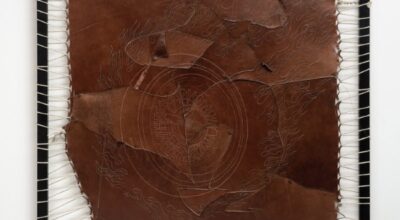
ECOFEMINISM(S)
By Monika Fabijanska | Curator
Ecofeminism is grounded in spiritual feminism, which insists that everything is connected –that nature does not discriminate between soul and matter. Ecofeminist art emerged in the late 1960s when the development of conceptual art, spiritual feminism, and the exclusion of women from the art market pushed their inventiveness far beyond the limitations of painting and classical art gallery presentation, and led to creating new mediums, driving art into new territories.
The political climate of the early 1970s heavily contributed: protests against the war in Vietnam, as well as growing concerns about limited resources, nuclearization, pollution, and over-population required new artistic languages. Ecofeminism is one of the richest albeit still little known caches of contemporary art. It is art that provokes the mind, and can inspire change. It also restores art’s function to what it was before the Enlightenment, when both science and art were tools to understand the world and propose solutions.

This exhibition presents some of the strategies of ecofeminist art, by its pioneers as well as the youngest generation of artists. It also provokes the question: if the ecofeminist art of the 1970s and 1980s was largely defined by Goddess art, ritual performances, anti-nuclear work, and feminist land art, what makes female environmental artists working today ecofeminists?
Historically, ecofeminism was marked by the struggle with patriarchal dualism between culture (a notion almost tantamount to civilization and progress) and nature; the dualism inseparable from the issue of gender roles. One response was Goddess art, aimed at reclaiming Herstory and the creator as a female, and at empowering women by asserting their connection with nature, yet the essence of the fight of early feminists may have best been expressed on the witty and perfectly aimed cover of Barbara Kruger’s exhibition catalog, We Won’t Play Our Nature to Your Culture (ICA London, 1983).

A minimalist feminist artist whose work has been awaiting rediscovery, Bilge Friedlaender’s (Turkish American, 1934-2000) installations made of handmade paper and natural materials such as linen, sticks, stones, sand and beeswax, like Heart Nests (1977), expressed ideas of care and maintenance, bundling, covering, and protection. Small in scale and made of natural materials, they reflected her ecological consciousness. In the series of works about Gilgamesh, which included handmade paper sculptures Cedar Forest (1989), Friedlaender exposed the story of the Sumerian king cutting the sacred cedar forest in quest for fame. She questioned the myth of the male hero, and reclaimed a female Goddess, Ishtar, as a metaphor for “the awakening of female consciousness.”1 Inspired by Jungian psychoanalysis, Friedlaender revisited the Epos of Gilgamesh for the 2nd International Istanbul Biennial in 1989, her first exhibition in Turkey since she had left forty years earlier.
Ana Mendieta’s (Cuban American 1948-1985) search for self and return to her homeland almost twenty years after her painful exile, produced a similar but more embracing response. Bacayu belongs to Esculturas Rupestres, a group of works she incised in natural caves during her trip to Cuba in July 1981 and named after the goddesses of Taíno, the indigenous people of Cuba. It was Mendieta’s “return to my land, to mother earth.”2 The feminist artist subverted monumental gestures of Land Art by working at a human scale in the landscape, and leaving no, or minimal, footprint.
Such ecological consciousness is inherent in the work of indigenous artists, whose practice has been an inspiration to others, including Helène Aylon, Aviva Rahmani, Betsy Damon, or Andrea Bowers. The unique oeuvre of Cecilia Vicuña (Chilean, b. 1948) is grounded in her understanding that the political, environmental and indigenous are inherently connected and must be addressed as such. In her vision, the object is merely the tangible manifestation of our will to return to being one with nature. Her Precarios (1966-present), tiny arrangements of natural and man-made materials such as driftwood, feathers, yarn, or wires, combine ritual and assemblage. According to the artist, they belong to the oceans from which many of their parts were collected and will not be fully complete until they return to the sea.
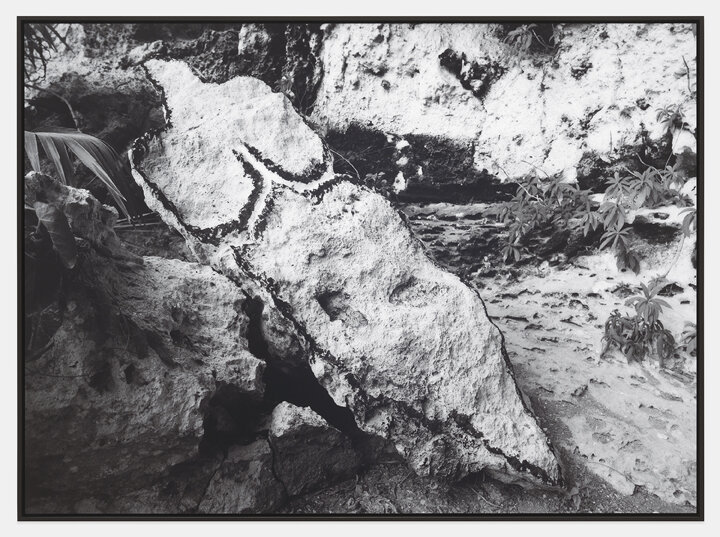
With Mark, Polar Bear (2019), Sonya Kelliher-Combs (American, b. 1969) honors the traditions of her people, Iñupiaq from the North Slope of Alaska and Athabascan from the Interior, and makes a damning comment on the American abuse of Alaska. The film Dystopia of a Jungle City, and the Human of Nature (2019) by Carla Maldonado (Brazilian, b. 1986), is a haunting ode to the daily life of indigenous people in fragile harmony with nature, and an alarming call for action against the far-right regime of Jair Bolsonaro, which aggressively attacked the laws protecting the Amazon Jungle and its people.
The recognition by pioneer ecofeminist artists that Western patriarchal philosophy and religions have served to subordinate and exploit both women and nature is particularly resonant in the era of the #MeToo Movement and Climate Change. Physical Education (1973) was the first performance in which Aviva Rahmani (American, b. 1945) made the connection between ecocide and the abuse of women. Its documentation, a photo essay symbolizing the man-made water cycle, is presented in its original format of a slide projection. Rahmani’s earliest, experimental body of work concerned with rape, which she created as part of early California performance scene, formed the base of her practical ecofeminism – “the work of artful repair to damaged ecosystems.”

Healing led to recultivation projects, and ecofeminist artists devoted particular attention to waste. Recultivation and waste projects were the most radical way of fulfilling the postulate of conceptual art and leaving the art gallery. Whether actions and performances, projects of ecological Land Art, or turning towards what could be considered urban planning, they almost always include the element of ritual. Secretive and intimate, or public, ecofeminist rituals signify purification and pay respect to the cycle of life, where birth, growth, change and decay are its natural stages.
Recognized as the first ecological site work, Agnes Denes’ (Hungarian-born American, b. 1931) Rice/Tree/Burial was first realized in 1968 in Sullivan County, NY, as a private ritual. In 1977-79, this ritual was re-enacted at a much larger scale at Artpark in Lewiston, NY, which was a former industrial dumpsite near Love Canal.3 Denes planted rice to represent life (the rice grew mutant due to soil toxicity), chained trees to indicate human interference with nature, and buried a letter to people in the future. The act of burial symbolized passing, reconnecting with soil and earth, and transformation. A synthesis of Land Art and performance, the project paved the way for Denes’ commitment to ecology in monumentally-scaled site works: “I do very large projects because there’s no sense doing little things in the corner to teach the world what needs to be done.”4

The same was Betsy Damon’s (American, b. 1940) motivation for her large public projects, like Living Water Garden in Chengdu, China (1998), a six-acre city park created to educate and demonstrate how water can clean itself through the use of natural processes. The Memory of Clean Water (1985), a cast of a dry riverbed in Utah in paper pulp, memorializing a river before it was dammed, was her pivotal work. Damon, active in 1970s in New York as a performance artist, whose work was strongly influenced by spiritual feminism and healing rituals, devoted her subsequent practice to public space projects focused on decontaminating waters.
Artists who address waste and contamination are mostly women: in their approach, the concept of care and maintenance as artistic practice, most famously proclaimed by Mierle Ukeles in Manifesto For Maintenance Art 1969!, meets the opposition to capitalist overproduction. The awareness that artists contribute to solid and chemical waste informs the scale of works and use of materials by such artists as Friedlaender and Vicuña.
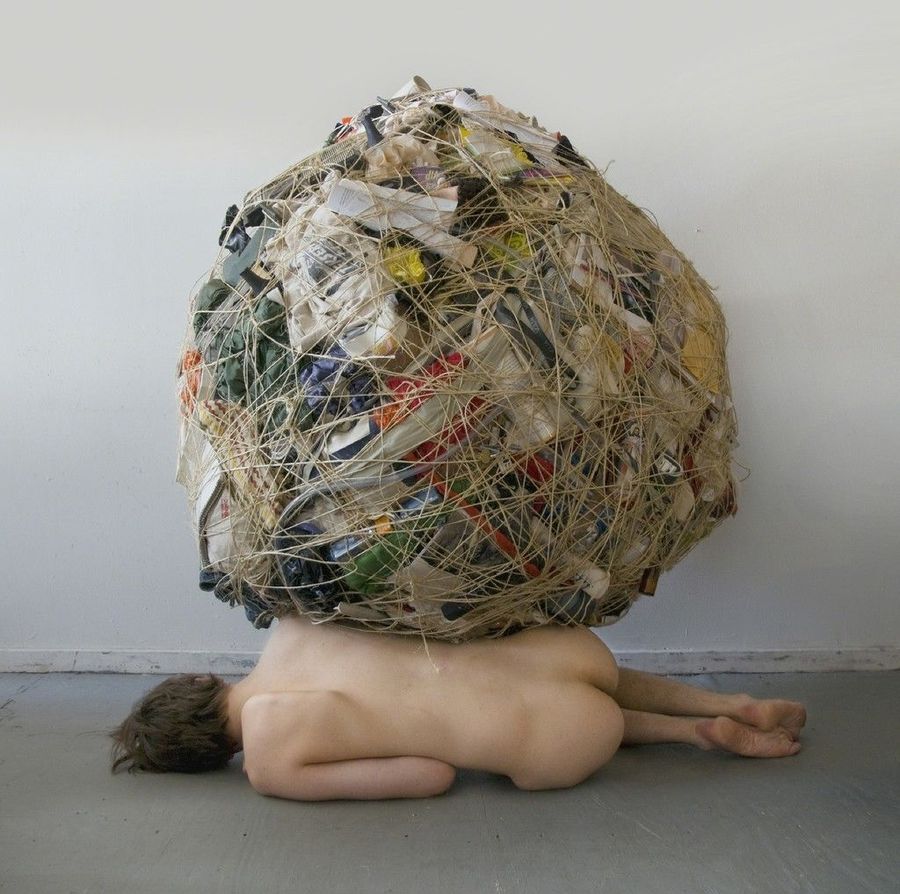
Among younger artists, this concern is strongly voiced by Mary Mattingly (American, b. 1978), who wrapped all her belongings into seven bundles, isolating them away from her life to “make monuments to things I stored.” She pushed or pulled these sculptures through streets in performances, and photographed them against the scale of human body (Life of Objects, 2013) or in natural habitats, pointing to their organic beginnings (The Damned Titian, again, 2013). By focusing on the mass-produced objects that she owns, Mattingly addressed the economy of global supply chains, which is based on the exploitation of resources and people.
The soil contaminated with nuclear waste required special care and rituals. One of the most original ecofeminist artists, a pro-peace and anti-nuclear activist in the 1980s, Helène Aylon (American, 1931-2020) tied the politics of war, which affects both human life and the environment, to the roots of our civilization in patriarchal religious systems. The Earth Ambulance carried pillowcases with earth “rescued” from fourteen selected SAC (Strategic Air Command) military bases across the country, from Berkeley to New York’s mass demonstration during SALT disarmament talks at the United Nations. Aimed at “confrontation and surveillance” at SACs, Aylon’s activist art involved ritual (“performance ceremonials”) and the collaboration of thirteen women. At the United Nations, they carried used army stretchers with the pillowcases, and emptied the earth into containers across the street from the UN.

The history and legacy of first-generation eco-feminism plays an important role in the work of Andrea Bowers’ (American, b. 1965), a tree sitter herself. A key aspect of her art is creating and protecting the records of activism, often ousted from the official annals, just like the history of women. Feminist Spirituality and Magical Politics Scrapbook (2003) belongs to the series Magical Politics, where she analyzed the spiritual roots of pioneer ecofeminist activists and memorialized their acts of civil disobedience, such as the 1980 Women’s Pentagon Action, or 1981 Mothers of Peace’ protest at the Diablo Nuclear Power Plant, in which Aylon most probably participated and where her Earth Ambulance passed by a few months later.
Ritual at the sites of nuclear contamination, and in landscapes generally, plays a special role in the art of Hanae Utamura (Japanese, b. 1980), who was born 80 miles from the Fukushima plant, a daughter of a scientist involved in the research of nuclear power generation. Utamura explores the connection between humans and earth using her physical body as a conduit. The central focus of her practice is the negotiation between nature and civilization, specifically, the relationship between man, science, and nature. By decentralizing human perspective, she enters the imagination of nature. In Secret Performance Series (2010-2013), the artist’s petite figure performs rituals in open landscapes some of which seem to be Sisyphean acts of taming nature; where nature itself is the main doer.
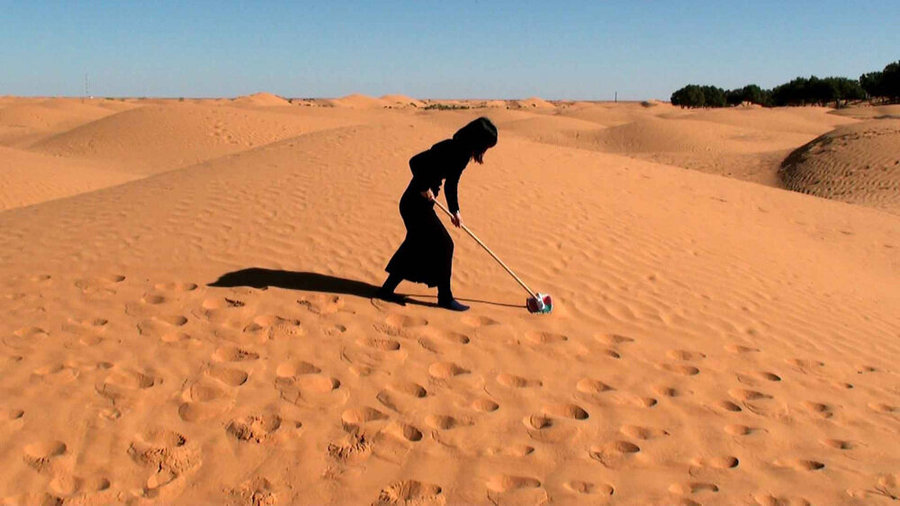
Since the 1970s, ecofeminism evolved from gender essentialism to understanding gender as a social construct to gender performativity. But today’s feminist artists still address the degradation of the environment by creating diverse responses to patriarchal power structure, capitalism, and the notion of progress. They invoke indigenous traditions in maintaining connection to nature and intensified the critique of colonialist politics of overextraction, water privatization, and the destruction of native peoples. They continue to employ social practice and activism, but focus on denouncing the ways in which global corporations affect the environment, and on designing futuristic proposals for life on earth, while celebration of the cycle of life seems to be less important motif today. Whether the earliest or the newest, ecofeminist projects are often collaborations with local communities and scientists.
If Agnes Denes’ futuristic projects for self-supporting city dwellings to withstand tremendous weather changes include a habitat suspended in air by a magnet (Model for a Teardrop, 2019), Mary Mattingly (American, b. 1978) imagines a post-apocalyptic world with a boat as a self-sustainable closed environment. Expecting greater migration as well as the increasing privatization of water, Mattingly’s photographs often portray scenes where nomadic individuals survive with the help of wearable technology or small self-contained systems, like in Microsphere: A Breathed Commune (2012). A floating food garden on a 130-foot barge with living quarters, rain water collection, and an autonomous solar power system, Swale (2016–ongoing) is Mattingly’s largest model of an autonomous living system so far. Informed by the realization that it is illegal to grow food on public land, it was conceived out of the artist’s concern for food security and keeping water as commons.
Inserting herself into corporate system, in Fugue in B Flat (2016), Jessica Segall (American, 1978) traveled with a bee rental business to the sites of brokered pollination. Most of her projects consider animals as equal cohabitants of the planet and involve interspecies art –sculptures designed for both people and animals. The piano sculpture where bees were introduced to hive was installed on Mary Mattingly’s Swale. Segall’s performances often involve perceived danger and propose tools for survival or provoke ideas for environmental conservation –a mourning ritual, A Thirsty Person, Having Found a Spring, Stops to Drink, Does Not Contemplate Its Beauty (2011), took place at the Global Seed Vault on the island of Spitsbergen.
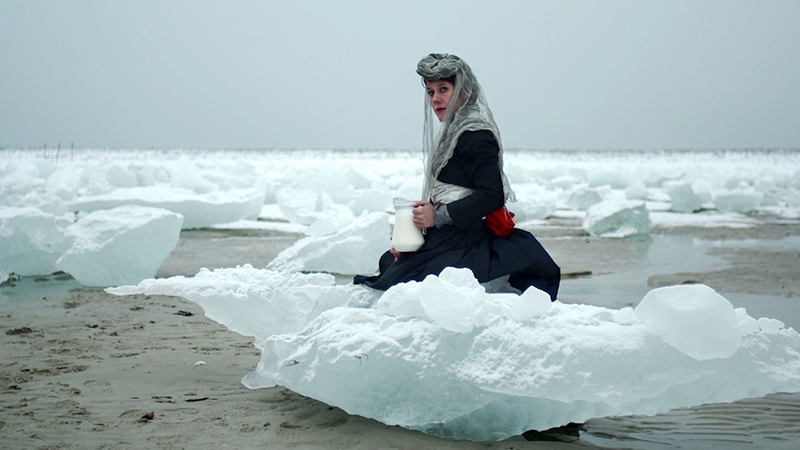
In the new project created for this exhibition, Eliza Evans (American) offers the mineral rights to 3 acres of her land in Creek County, Oklahoma, for sale to 1,000 people, in order to prevent fossil fuel development in the area. In the vein of Agnes Denes’ 1992 project Tree Mountain – A Living Time Capsule – 11,000 Trees, 11,000 People, 400 Years realized in Finland, Evans’ All the Way to Hell (2020-ongoing) offers us the opportunity to participate and the responsibility to make change. The project consists of actual mineral deeds for buyers and an installation.
Lynn Hershman Leeson (American, b. 1941), acclaimed for the pioneering use of new technologies, is an artist who “lives” in the future. In Twisted Gravity(2020), being developed at Harvard University, she engages with the latest in applied science –a revolutionary off-the-grid water filter able to kill bacteria and degrade plastic through electricity (Aqua Pulse) and by using waxworms to digest plastic (Evolution). The project grows out of her early feminist works that examined woman’s perpetual transformation and survival –Roberta Breitmore (1974–78) and Water Women (since 1978). In the new work, the idea of survival through change meets the feminist interest in change as a life cycle. The filter’s action is made visible when purification cycle sends light through the body of Water Woman, etched in a transparent plate. She “comes alive” the moment bacteria are killed and plastic disappears.
Ultimately, ecofeminist art is not there just to be looked at, provoke or simply be admired. It proposes solutions for the planet and our survival – both spiritual and practical.
- Press release, the exhibition at the Jessica Berwind Gallery, Philadelphia, 1993
- Pamphlet, the exhibition Ana Mendieta: Geo-Imago, Museo Nacional de Bellas Artes, Havana, 1983, where these photographs were probably included.
- A location of a landfill that became the site of a mass environmental disaster in the 1970s.
- Lescaze Z., “Sandwoman: Land Artist Agnes Denes Has a Plan for the Rockaways,” Observer, July 16, 2013
ecofeminism(s)
Andrea Bowers, Helène Aylon, Eliza Evans, Sonya Kelliher-Combs, Hanae Utamura, Betsy Damon, Aviva Rahmani, Jessica Segall, Lynn Hershman Leeson, Bilge Friedlaender, Carla Maldonado, Mary Mattingly, Cecilia Vicuña, Barbara Kruger, Agnes Denes
Thomas Erben Gallery, 526 West, 26th Street, Suite 412-413, New York, NY
June-July 2020
También te puede interesar
Almost Solid Light:new Work From Mexico
Paul Kasmin Gallery (New York) presents "Almost Solid Light", an exhibition of contemporary Mexican artists, celebrating the long history of cultural cross-pollination between neighboring nations. The exhibition brings together artists practicing in diverse media...
JOSÉ DE JESÚS RODRÍGUEZ AND ESTEBAN RAMÓN PÉREZ: SOBRE LAS OLAS
What Jose and Esteban show is that this in-betweenness is useful, both aesthetically and elsewhere. It is the place of nepantla—that generative space between here and there, between abstraction and figuration, between the parts...
Ch.ACO Y LOS SÍNTOMAS RECURRENTES DEL MERCADO DEL ARTE EN CHILE
Como primer acercamiento, plano y general, a lo que fue la feria de arte Ch.ACO 2014, diríamos que fue más abordable al acotar el número de galerías participantes, que la infraestructura bajó de calidad, pero…


